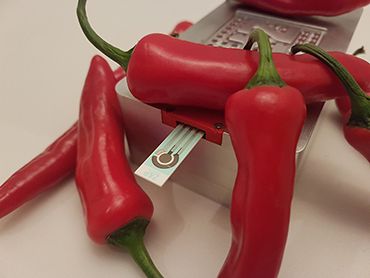Measuring chilli heat with electrochemistry
The success of University of Oxford chemists in using electrochemical sensing to detect the spiciness of chillies has led to the recent development of new sensors for garlic, turmeric and ginger.
 The ChilliPot sensor.
The ChilliPot sensor.(Image credit: Zimmer & Peacock)
For over 100 years, the standard method of assessing chilli strength has been the Scoville Test. A chilli sample is repeatedly diluted and given to a panel of five expert tasters until a majority of them can no longer detect the heat. The dilution level gives a number that describes the strength of the original chilli.
Not surprisingly, the accuracy of the Scoville Test is entirely dependent on how sensitive the tasters are to capsaicin, the molecule that gives chilli its heat. It is also time-consuming and costly to perform. It is possible to measure capsaicin content using more consistent scientific methods, but these require expensive lab-based equipment and trained staff.
What manufacturers needed was a simple, hand-held device that could be used to test chilli strength. This is precisely what Professor Richard Compton and his group at the University of Oxford have achieved with their ChilliPot sensor, produced in collaboration with Zimmer & Peacock (ZP), an electrochemical sensor manufacturing company.
The science underpinning the ChilliPot was born out of the Compton group’s expertise in electrochemistry. Molecules of capsaicin stick to a sensor covered in carbon nanotubes. The more that stick, the stronger the signal, and the hotter the chilli. The ChilliPot can give an accurate chilli strength reading in less than a minute – altogether quicker, cheaper and more accessible than the Scoville Test.
The success of the ChilliPot triggered further food industry challenges: could similar sensors measure levels of turmeric, ginger or garlic? Like chilli, ginger and garlic are used in huge quantities but batches can vary significantly in terms of flavour strength. Turmeric is expensive, and so may be adulterated with other compounds (including poisonous lead chromate), which makes standardisation particularly important.
It turns out that the active ingredients in turmeric and ginger (curcumin and gingerol respectively) can be detected using carbon nanotube electrodes in a similar way to capsaicin in chillies. The garlic sensor uses a different but equally effective electrochemical method. Sensors for all three foods are now licensed to ZP in a successful commercial partnership.
Professor Compton and his colleagues now plan to use this technology to solve further challenges, such as the electrochemical detection of bacteria like E. coli. The group has also patented techniques for saliva-based cannabis detection and environmental nanoparticle detection.
Research funded by: Engineering and Physical Sciences Research Council